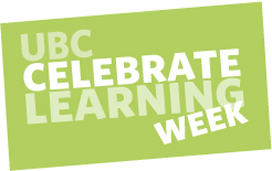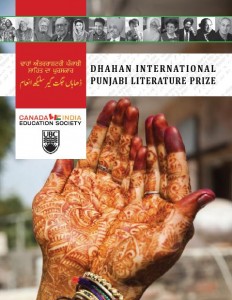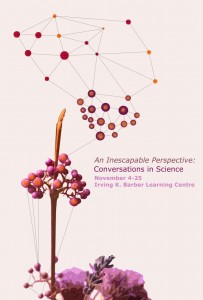
Monday, October 21
Positive Psychology – What Is It? Examples From Our Work
Monday, October 21, 12:00pm – 2:00pm
Room 302, Dodson Room, 3rd floor, Irving K. Barber Learning Centre
FREE
Preparing for the Present: Exploring The Value of Mindfulness For Teaching & Learning
Monday, October 21, 1:00pm – 2:20pm
Seminar Room 2.22, Irving K. Barber Learning Centre
FREE
TLEF Showcase
Monday, October 21, 3:30pm – 5:00pm
Golden Jubilee Room, 4th floor, Irving K. Barber Learning Centre
FREE
TLEF Poster Display
Running all week, Monday, October 21 – Friday, October 25
2nd Floor Atrium, Irving K. Barber Learning Centre
FREE
Our Truth: Truth and Reconciliation at UBC
Running all week, Monday, October 21 – Friday, October 25
2nd Floor Foyer, Irving K. Barber Learning Centre
FREE
Tuesday, October 22
Open UBC Week: Open Access Megajournals – Have They Changed Everything?
Tuesday, October 22, 9:30am – 10:50am
Room 302, Dodson Room, 3rd floor, Irving K. Barber Learning Centre
FREE – Please Register
Open UBC Week: The Future? Open Online Courses and the Library
Tuesday, October 22, 11:00am – 11:50am
Room 302, Dodson Room, 3rd floor, Irving K. Barber Learning Centre
FREE – Please Register
What Happens On The Bus Doesn’t Stay On The Bus: The Reproduction of Coercion and Rape Culture
Tuesday, October 22, 12:30pm – 1:30pm
Room 182, Irving K. Barber Learning Centre
FREE
Open UBC Week: Open Textbooks Workshop
Tuesday, October 22, 1:00pm – 1:50pm
Room 302, Dodson Room, 3rd floor, Irving K. Barber Learning Centre
FREE – Please Register
Mental Health in the UBC Workplace – Responding with Respect
Tuesday, October 22, 1:30pm – 4:30pm
Room 301, Lillooet Room, 3rd floor, Irving K. Barber Learning Centre
FREE – Please Register
Open UBC Week: Muzzles, Media Offices and Message Control
Tuesday, October 22, 2:00pm – 2:50pm
Room 302, Dodson Room, 3rd floor, Irving K. Barber Learning Centre
FREE – Please Register
Open UBC Week: Open Robotics and 3D Printing Demo
Tuesday, October 22, 3:00pm – 3:50pm
Room 302, Dodson Room, 3rd floor, Irving K. Barber Learning Centre
FREE – Please Register
BC’s New Education Plan: School Libraries at the Centre of Learning
Tuesday, October 22, 4:30pm – 6:00pm
Room 302, Dodson Room, 3rd floor, Irving K. Barber Learning Centre
FREE
TLEF Poster Display
Running all week, Monday, October 21 – Friday, October 25
2nd Floor Atrium, Irving K. Barber Learning Centre
FREE
Our Truth: Truth and Reconciliation at UBC
Running all week, Monday, October 21 – Friday, October 25
2nd Floor Foyer, Irving K. Barber Learning Centre
FREE
Wednesday, October 23
Open UBC Week: Open Freedoms/Open Practices
Wednesday, October 23, 10:00am – 10:50am
Room 302, Dodson Room, 3rd floor, Irving K. Barber Learning Centre
FREE – Please Register
Open UBC Week: The Whys and Hows of Open — Transforming Learning Through Open Pedagogies and Practices
Wednesday, October 23, 11:00am – 11:50am
Room 302, Dodson Room, 3rd floor, Irving K. Barber Learning Centre
FREE – Please Register
Open UBC Week: Reclaiming the Open Learning Environment
Wednesday, October 23, 1:00pm – 1:50pm
Room 302, Dodson Room, 3rd floor, Irving K. Barber Learning Centre
FREE – Please Register
Flexible Learning Showcase
Wednesday, October 23, 1:00pm – 4:00pm
Room 301, Lillooet Room, 3rd floor, Irving K. Barber Learning Centre
FREE – Please Register
Open UBC Week: How Students Are Leading Open Access
Wednesday, October 23, 2:00pm – 2:50pm
Room 302, Dodson Room, 3rd floor, Irving K. Barber Learning Centre
FREE – Please Register
Open UBC Week: MOOCs and On-Campus Learning
Wednesday, October 23, 3:00pm – 3:50pm
Room 302, Dodson Room, 3rd floor, Irving K. Barber Learning Centre
FREE – Please Register
TLEF Poster Display
Running all week, Monday, October 21 – Friday, October 25
2nd Floor Atrium, Irving K. Barber Learning Centrel
FREE
Our Truth: Truth and Reconciliation at UBC
Running all week, Monday, October 21 – Friday, October 25
2nd Floor Foyer, Irving K. Barber Learning Centre
FREE
Thursday, October 24
Reflecting on Our Truth at UBC
Thursday, October 24, 9:00am – 11:45am
First Nations House of Learning, Sty-wet-tan, 1985 West Mall
FREE
How Learning Works
Thursday, October 24, 9:30am – 12:30pm
Room 302, Dodson Room, 3rd floor, Irving K. Barber Learning Centre
FREE – Please Register
eBook Fair and Vendor Panel
Thursday, October 24, 10:00am – 3:30pm
Room 301, Lillooet Room, 3rd floor, Irving K. Barber Learning Centre
FREE
A Holistic Approach to Sustainability Course Design
Thursday, October 24, 12:00pm – 1:30pm
Seminar Room 2.22, Irving K. Barber Learning Centre
FREE
TLEF Poster Display
Running all week, Monday, October 21 – Friday, October 25
2nd Floor Atrium, Irving K. Barber Learning Centre
FREE
Our Truth: Truth and Reconciliation at UBC
Running all week, Monday, October 21 – Friday, October 25
2nd Floor Foyer, Irving K. Barber Learning Centre
FREE
Friday, October 25
Teaching Through Visual Cognition In An Immersive Online Environment
Friday, October 25, 3:00pm – 4:30pm
Room 301, Lillooet Room, 3rd floor, Irving K. Barber Learning Centre
FREE
Music on the Point: Concerts with Personality
Friday, October 25, 7:30pm
Roy Barnett Recital Hall, Music Building, 6361 Memorial Road
$25 Adults | $25 UNA & Town@UBC members (with card) | $15 Students – Please Register
TLEF Poster Display
Running all week, Monday, October 21 – Friday, October 25
2nd Floor Atrium, Irving K. Barber Learning Centre
FREE
Our Truth: Truth and Reconciliation at UBC
Running all week, Monday, October 21 – Friday, October 25
2nd Floor Foyer, Irving K. Barber Learning Centre
FREE
Saturday, October 26
Celebrate Science 2013 Making Science Fun
Saturday, October 26, 9:30am – 12:30pm
Beaty Biodiversity Museum, 2212 Main Mall
FREE – Please Register
Introduction to Public International Law
Saturday, October 26, 9:30am – 4:00pm
Irving K. Barber Learning Centre, TBA
$75 – Please Register
Pyramids and Tombs
Saturday, October 26, 9:30am – 4:00pm
Irving K. Barber Learning Centre, TBA
$75 – Please Register
Understanding Brain Dysfunction: Mechanisms, Symptoms and Treatment
Saturday, October 26, 9:30am – 4:00pm
Irving K. Barber Learning Centre, TBA
$75 – Please Register
Dealing With Difficult People
Saturday, October 26, 10:00am – 4:00pm
Irving K. Barber Learning Centre, TBA
$205 + Tax – Please Register.
Multiple-Day Events
TLEF Poster Display
The Teaching and Learning Enhancement Fund supports innovative projects designed to improve the student learning experience at UBC-V. A variety of successful applicants have created posters detailing what they are doing with their funding and how it is impacting the student experience. Feel free to visit this interesting and informative display at any time during Celebrate Learning Week. This display will be launched by the TLEF Showcase, in which project leaders will speak about their projects and answer audience questions (Monday, October 21, 12:00pm).
Dates of TLEF poster display: Monday, October 21 – Friday, October 25, 2013
Location: 2nd Floor Atrium, Irving K. Barber Learning Centre, 1961 East Mall
TA Training Poster Display
This TA Training poster display will showcase the different processes departments and faculties use to train their teaching assistants. It is intended to provide information to students who may be interested in becoming TAs, and it is also an opportunity for faculties to share information with each other about their approaches to TA Training.
Dates of TLEF poster display: Monday, October 21 – Friday, October 25, 2013
Location: 2nd Floor (Adjacent to Outpost Store), Student Union Building, 1638 Student Union Boulevard
Our Truth: Truth and Reconciliation at UBC
From September 17, 2013 to October 31, 2013 the Irving K. Barber Learning Centre will be hosting a small exhibit in the foyer to invite the community to learn more about the Truth and Reconciliation Commission.
Dates of Our Truth: Monday, October 21 – Friday, October 25, 2013
Location: 2nd Floor Foyer, Irving K. Barber Learning Centre, 1961 East Mall
For other events happening at the Irving K. Barber Learning Centre and UBC campus as part of Celebrate Learning Week, please find here.
 Tuesday, October 8th, 2013 at 7:00 pm
Tuesday, October 8th, 2013 at 7:00 pm

